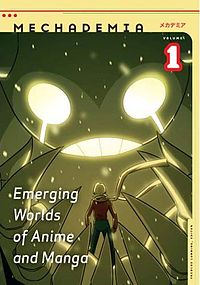- Mechademia
-
Mechademia 
Abbreviated title (ISO) Mechademia Discipline Media studies Language English Edited by Frenchy Lunning Publication details Publisher University of Minnesota Press (United States) Publication history 2006-present Frequency Annually Indexing ISSN 1934-2489 (print)
2152-6648 (web)LCCN 2006215646 OCLC number 72523390 Links Mechademia: An Annual Forum for Anime, Manga, and the Fan Arts is a peer-reviewed academic journal in English about Japanese popular culture products and fan practices. It is published by the University of Minnesota Press and edited by Frenchy Lunning.[1]
Contents
List of volumes
No. Title Release date ISBN 01 Mechademia 1: Emerging Worlds of Anime and Manga December 22, 2006[2] ISBN 978-0-8166-4945-7[3] 02 Mechademia 2: Networks of Desire December 26, 2007[4] ISBN 978-0-8166-5266-2[5] 03 Mechademia 3: Limits of the Human November 5, 2008[6] ISBN 978-0-8166-5482-6[7] 04 Mechademia 4: War/Time November 11, 2009[8] ISBN 978-0-8166-6749-9[9] 05 Mechademia 5: Fanthropologies November 9 2010[10] ISBN 978-0-8166-7387-2[11] 06 Mechademia 6: User Enhancement Fall 2011[12] — 07 Mechademia 7: Lines of Sight Fall 2012[12] — 08 Mechademia 8: Tezuka Osamu: Manga Life[13] Fall 2013[12] — Reception
Steve Raiteri from Library Journal commends Mechademia as a "great first effort [...] bridg[ing] the gap between academics and fans."[14] Christophe Thouny, writing for Animation also thought the writing and tone was accessible by both academics and fans.[15] Ed Sizemore from Comics Worth Reading criticizes the journal for its review and commentary section because they "read like summaries of the works (films and books) discussed with no actual critique of the work". However, Sizemore commends the journal's academic essay section.[16] By contrast, Raiteri in Library Journal states that fans will find the Review and Commentary section "the most accessible" section of the journal.[14] Kevin Gifford contrasts Mechademia with shallower works on anime, praising its "insightful essays and reviews" and detail, calling it "worthwhile reading for anyone hungry for intelligent writing" about anime.[17] Tomo Hirai of the Nichi Bei Times described the first volume as "an informative and inspiring read for those curious beyond the skin of anime".[18]
A review of the second volume of Mechademia by Comics Worth Reading's Johanna Draper Carlson criticises the journal for its dry tone and "flat statements following after each other separated only by footnote numbers".[19] A later review by Ed Sizemore recommends that Mechademia "should stop trying to develop a theme for each issue".[20] ActiveAnime's Holly Ellingwood comments that the journal's "strong academic bent may put off some potential readers but give it a chance and peruse through the many varied topics".[21] A later review by Holly Ellingwood commends the third volume of Mechademia as being "extremely insightful and thought provoking ... [about] anime, manga, and even the future of mankind".[22] William McClain criticises the fourth volume for having articles that are "too restrictive" in focus, calling attention to the lack of discussion, in this volume, of how anime and manga culture has spread internationally. McClain also criticises the volume for not including enough visual aids for the general reader, but praises the Mechademia journal as a whole for its experimental approach.[23] Ellen Grabiner feels that War/Time takes the approach that war has become everyday in post-war Japanese society, and praises the broad range of essays.[24] Timothy Iles feels that the strength of Mechademia is that it provides "theoretically informed, historically grounded, jargon-free research that highlights first and foremost, not the self-serving virtuosity of the researcher, but the interpretive depth of the material under analysis."[25]
References
- ^ Koulikov, Mikhail (January 26, 2005). "2004 Year in Review Anime/Manga Academic Highlights". Anime News Network. http://www.animenewsnetwork.com/feature/2005-01-26/5. Retrieved 2009-05-16.
- ^ "Mechademia 1: Emerging Worlds of Anime and Manga (Mechademia)". Amazon.com. http://www.amazon.com/dp/0816649456. Retrieved 2009-05-16.
- ^ "Mechademia 1". University of Minnesota Press. http://www.upress.umn.edu/Books/L/lunning_mechademia1.html. Retrieved 2009-05-16.
- ^ "Mechademia 2: Networks of Desire (Mechademia)". Amazon.com. http://www.amazon.com/dp/081665266X. Retrieved 2009-05-16.
- ^ "Mechademia 2". University of Minnesota Press. http://www.upress.umn.edu/Books/L/lunning_mechademia2.html. Retrieved 2009-05-16.
- ^ "Mechademia 3: Limits of the Human (Mechademia)". Amazon.com. http://www.amazon.com/dp/0816654824. Retrieved 2009-05-16.
- ^ "Mechademia 3". University of Minnesota Press. http://www.upress.umn.edu/Books/L/lunning_mechademia3.html. Retrieved 2009-05-16.
- ^ "Mechademia 4: War/Time (Mechademia) (Paperback)". Amazon.com. http://www.amazon.com/dp/0816667497. Retrieved 2009-11-17.
- ^ http://www.upress.umn.edu/Books/L/lunning_mechademia4.html
- ^ "Mechademia 5: Fanthropologies (Paperback)". Amazon. http://www.amazon.com/dp/081667387X. Retrieved 2011-03-03.
- ^ http://www.upress.umn.edu/Books/L/lunning_mechademia5.html
- ^ a b c "Mechademia 1-5 available to order". Mechademia. http://mechademia.org/?p=45. Retrieved 2011-10-02.
- ^ http://mechademia.org/?p=264
- ^ a b Raiteri, Steve (2007-01-15). "Graphic Novels: Religion and Comics". Library Journal. http://www.libraryjournal.com/article/CA6403916.html. Retrieved 2009-05-16.
- ^ Thouny, Christophe (2008). "Untitled Review". Animation 3 (2): 212–217. doi:10.1177/17468477080030020703.
- ^ Sizemore, Ed (June 25, 2007). "Mechademia 1". Comics Worth Reading. http://comicsworthreading.com/2007/06/25/mechademia-1/. Retrieved 2009-05-16.
- ^ Gifford, Kevin (February 2007). "Mechademia Volume 1: Anime Research Gets Serious". Newtype USA: 139.
- ^ Hirai, Tomo. "Book Review: Academia and Fandom Meet In New Study of Anime and Manga". Nichi Bei Times. http://www.nichibeitimes.com/?p=1312. Retrieved 2009-05-16.
- ^ Draper Carlson, Johanna (September 14, 2008). "Mechademia 2: Networks of Desire". Comics Worth Reading. http://comicsworthreading.com/2008/09/14/mechademia-2-networks-of-desire/. Retrieved 2009-05-16.
- ^ Sizemore, Ed (February 24, 2009). "Mechademia 3: Limits of the Human". Comics Worth Reading. http://comicsworthreading.com/2009/02/24/mechademia-3-limits-of-the-human/. Retrieved 2009-05-16.
- ^ Ellingwood, Holly (January 18, 2007). "Mechademia: Emerging Worlds of Anime and Manga". ActiveAnime. http://www.activeanime.com/html/content/view/118/57/. Retrieved 2009-05-16.
- ^ Ellingwood, Holly (January 4, 2009). "Mechademia Vol 3: Limits of the Human". ActiveAnime. http://www.activeanime.com/html/content/view/4391/57/. Retrieved 2009-05-16.
- ^ http://ijoc.org/ojs/index.php/ijoc/article/view/961/478
- ^ http://www.english.ufl.edu/imagetext/archives/v5_4/grabiner/
- ^ http://www.japanesestudies.org.uk/reviews/2011/Iles3.html
Further reading
- Boulter, Jonathan (2011). "Mechademia 4: War/Time (review)". Science Fiction Film and Television 4 (2): 287–291.
- Ratelle, Amy (2011). "Mechademia 3: Limits of the Human. Edited by Frenchy Lunning. Minneapolis: University of Minnesota Press, 2008. 287 pp. $19.95 (paper).". The Journal of Asian Studies 70 (2): 574–575. doi:10.1017/S0021911811000507.
- Wilson, D. Harlan (July 2010). "Lunning’s Mechademia 3: Limits of the Human". Science Fiction Studies.
External links
Categories:- Anime and manga magazines
- Media studies journals
- University of Minnesota
- Publications established in 2006
- English-language journals
- Annual journals
Wikimedia Foundation. 2010.
